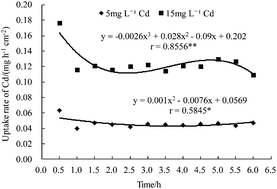Cadmium uptake, chemical forms, subcellular distribution, and accumulation in Echinodorus osiris Rataj
Abstract
Phytoremediation is a technology for extracting or inactivating pollutants in soil. Echinodorus osiris (E. osiris) is a fast growing perennial wetland plant that is common in tropical and subtropical areas and has a high tolerance to cadmium (Cd). However, the absorption dynamics, subcellular distribution and accumulation of Cd by E. osiris had not been investigated. In this paper, hydroponic experiments with different levels of Cd2+ (0, 5.0, 15.0 mg L−1) were carried out to determine these characteristics of E. osiris. The results indicated that the Cd absorption rate of Echinodorus osiris decreased over time, and the absorption rate within 0.5–1.0 h was faster than after 1.0 h. In a 6.0 hour time period, the rate of Cd uptake fit a quadratic polynomial curve when E. osiris was grown under the 5 mg L−1 Cd treatment. However, the rate of Cd uptake by E. osiris fit a cubic polynomial model with the 15 mg L−1 Cd treatment. In the roots, the


 Please wait while we load your content...
Please wait while we load your content...